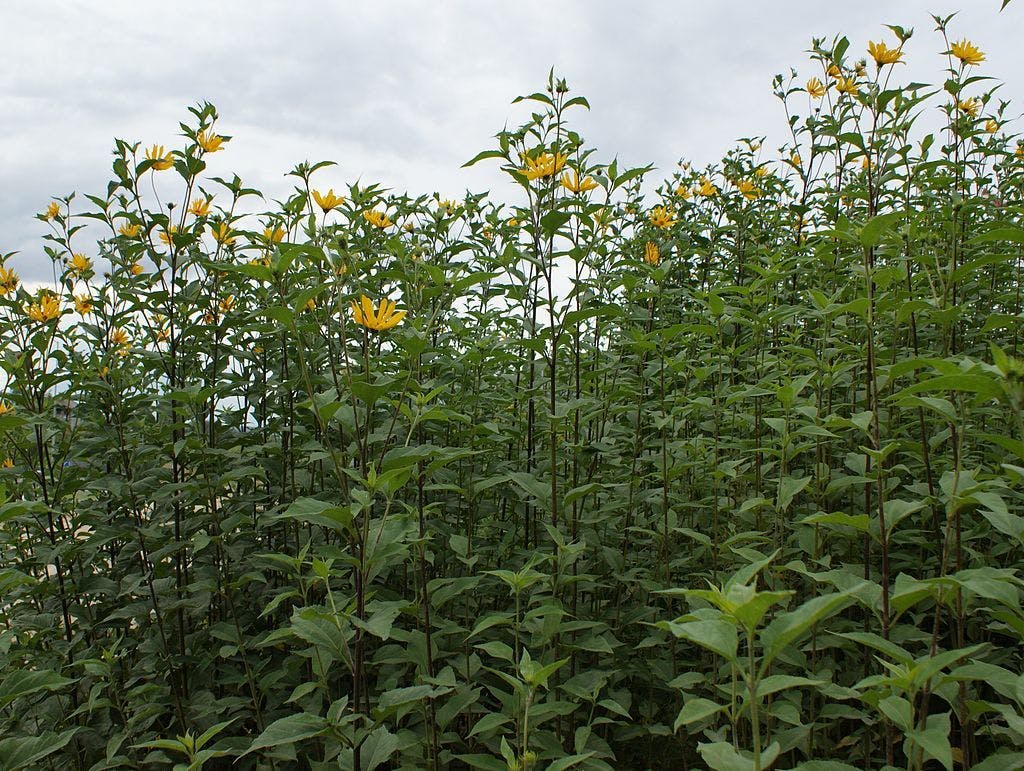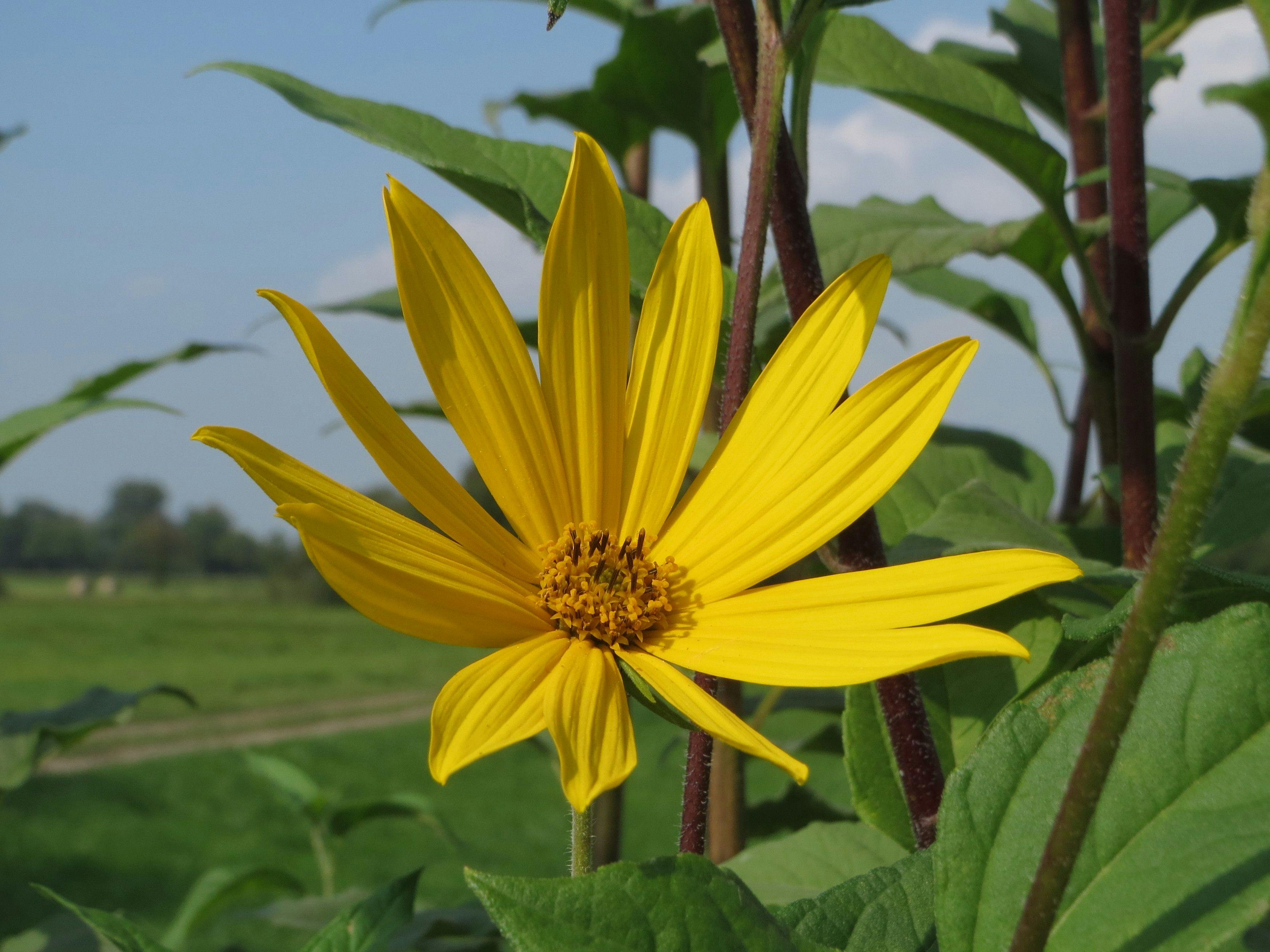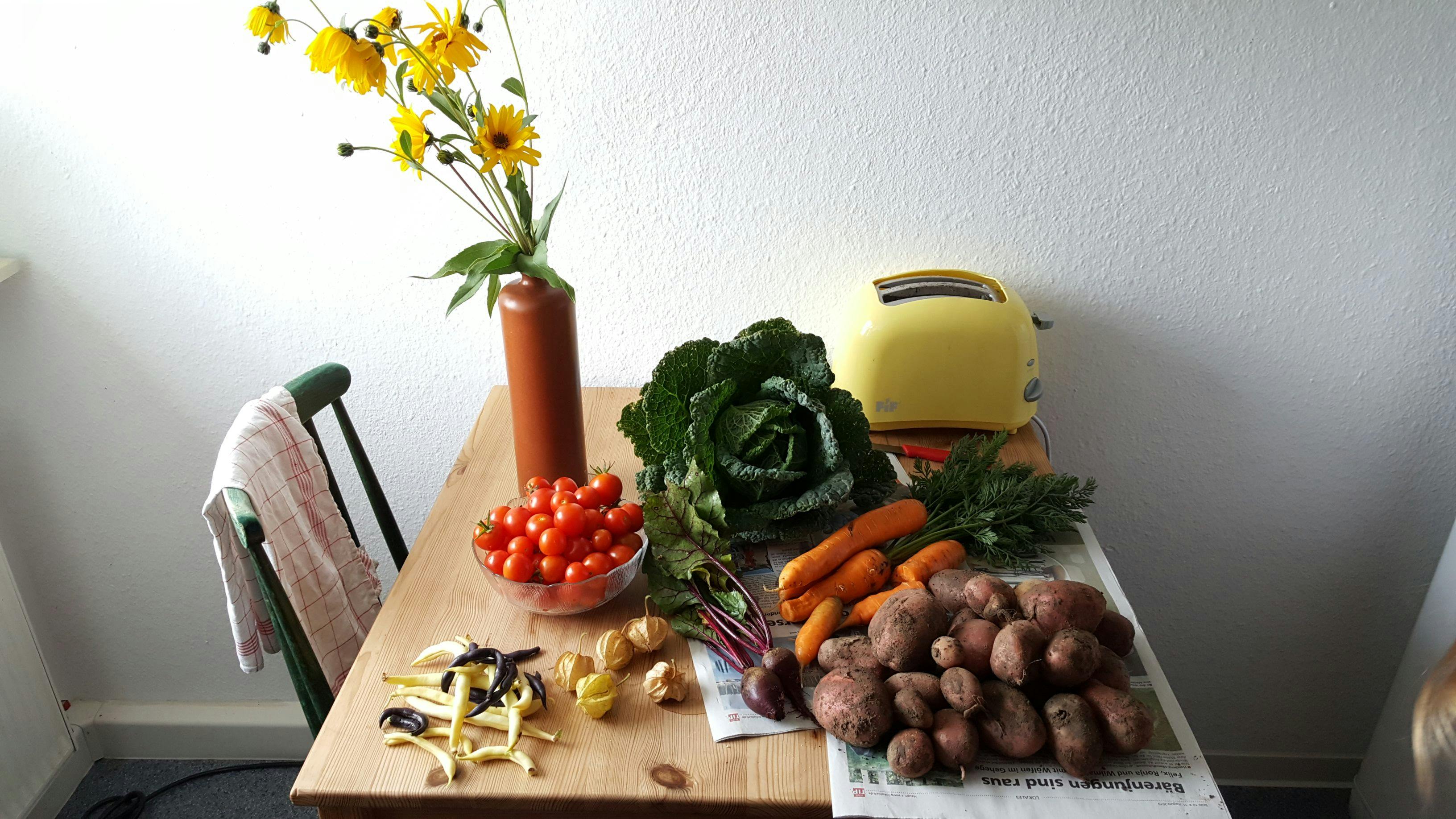How do we get to know new species? Plants can spread over wide territories. In our globalised economy, we trade plants throughout the world - as fruits, vegetables, cut flowers, garden plants - but under set conditions (e.g. promoted by the International Plant Protection Convention (IPPC)). Those plants who escape strict administration enter as invasive alien species, and must find ways to live under new conditions. Plants try to fit in. How long that takes depends on many ecological and social factors. On a small scale they bring new looks to our gardens and to our diets. They blend in. We learn to care for them, to live with them and to use them. If they escape our garden administration, they may enter into the wider ecosystem nearby and probably change it. Maybe they just add a little nourishment or colour to their new environment. Maybe they strive so well that they change the natural landscape. If fellow humans accept this. Their acceptance depends on conceptions of nature, because nature is something different to everyone. Nature is cultural (Descola 2013); it has different faces depending on the angle from which you look at it (Ingold 2000; Schriewer 2001). It is embedded in social practices (Shove, Pantzar & Watson 2012).
Here, I want to explore what this means in a German city where I did ethnographic research with an urban gardening initiative that is trying to slowly and sustainably transform the urban landscapes into an edible city. Throughout the story you will see, how present and absent knowledge is influencing practices with a specific plant_._ Helianthus tuberosus (in German: Topinambur, in English: Jerusalem artichoke) was introduced from North America to Europe in the 17th century, long before the IPPC was invented, and today is classified by the German Federal Agency for Nature Conservation (Bundesamt für Naturschutz—BfN) as an invasive alien species, but only as a minor threat to German landscapes (BfN 2003). The plant has a long history in Europe. As a wild flower throughout Germany, it mostly lives near rivers. As a food it is very nutritious and was cultivated in Europe before potatoes where introduced, which then became more popular (ibid.). While the use of Topinambur in human diets in Germany almost vanished, until today the tubers are used for grazing, e.g. of boars. This is also the case with other plants. For example, acorns were part of the western Spanish cuisine, but today they are only used to feed the famous Iberico pigs (García-Gomez et al. 2017). The knowledge how to prepare Helianthus tuberosus only recently regained more attention, mostly as an organic food (BfN 2003). And this is where the story begins.

In this practice theory inspired story, I will show how Topi is linked to materials, meanings and competences (Shove, Pantzar & Watson 2012, 14) that are shared in a German urban gardening community. Throughout the text, I will use the German common name Topinambur to go with the anthropological convention to use terms from the field whenever possible. All names of persons have been changed—except that of Topi. This is a story about how the practices involving Topinambur, the materials, places involved (gardens and soil) and the competences of humans involved these practices change over time, because the plant's characteristics change the meanings inscribed in related practices. Perhaps change is inherent to the continuation of plant practices.

The kitchen is a large room with a big table and all kinds of chairs around it - some broken, some intact. Laura and I are cutting vegetables from the CSA (Community Supported Agriculture) at the kitchen island. Suddenly she offers me a sieve made from stainless steel and says: "Do you want to try one?" I peek into the shiny sieve onto a handful of brown and dirty tubers. My look must have been sceptical, because Laura adds that she eats Topi regularly and that you can eat it uncooked. Here, two meanings of Topi collide: for Laura it is a nutritious plant, for me something suspiciously looking. Topi evokes delight and uncertainty at the same time.
Numerous thoughts run through my head while I make a muttering sound towards Laura who still offers me the tubers with a smile. I have already eaten Topinambur once or twice and I liked the taste -- cooked, I tell her. However, I have also heard that, like potatoes, it is unwise to eat it raw. (At home, I found out that this is not true. There are numerous salad recipes with Topi.) So I ask her if the raw tubers have the same effects as potatoes - which she denies. She is keen to remove the alleged danger from the tubers. "I'll wash them, and then they look better. Of course, with all this dirt it's not tasty!" It might sound trivial, but here one important competence for dealing with edible plants becomes obvious—you have to know how to prepare it and to make it look good is certainly essential to the preparation of food.
"Do you bring them from your garden?" I ask, because from various occasions I know that in this urban gardening community Topinambur is infamous for causing substantial changes to private gardens. Every time someone mentions it, you can hear people sigh, laugh, and tell about their experiences with "Topi". At a market venue, I once overheard two women shop talking and laughing about how beautiful they found the big yellow blossoms at first. They called it "Topi", a rather affectionate short form—one you would maybe call a friend or at least someone you know closely. They argued about what a nuisance the plant was as it spread throughout the whole garden and was almost impossible to stop, because its roots spread underground and it was hard to find every root to stop it from spreading. Even cold winters did not hinder Topi from spreading. The ability of Helianthus tuberosus to survive under various conditions is well known (Swanton 1986). Hence, to be able to tolerate Topi in your life, you, first, need to know about its "spreading" character. Its meaning often changes from a beautiful edible plant to an invader that disturbs what you had pictured your private garden to look like.
Back to the kitchen: Obviously, Alice just overheard our conversation, shouting over that she once planted Topinambur in her garden and still regrets it, even though the blossoms were beautiful. Laura agrees and shows off a little bit. Last year, she cleverly planted Topi in an old, unused bathtub in her garden. That saved her from having to dig up all the tubers. What Laura found most exciting was the little mouse that chose this bathtub as her home. The happiest mouse in the world, Laura says laughing, because she figured that the mouse ate all the Topinambur tubers and never had to care for fodder all summer. Here we can see how all three aspects of the practice of "living with Topinambur_" come together: Laura did not only know what it means to plant a_ Topinambur plant, but also had the material (bathtub) and skills (knowledge) to construct a habitat that seemed suitable for her living together with Topi -- and the mouse. We also see how in this case the practice of planting intersects with the practice of recycling old household devices. Knowledge, mostly gained from experience circulates between these practices that form a new practice (a new form of garden administration) if they are linked.
We get back to the question of where these tubers are from. Laura offers some for me to take home. She ordered hers from the forest ranger station and has a sackful of it. I look at her puzzled. Why did she order so much if she does not plan to plant them this year? She willingly admits that they only sell large quantities, because this kind of Topi is supposed to be fodder for boars. Hunters or foresters are using it to attract boars to a certain spot to shoot them. Laura laughs. The boars really love Topi, just like herself, she explains. My reaction shows astonishment. (I leave aside the strange feeling transported by eating fodder for boars that they get to be easier to shoot at a vegan kitchen venue.) Are the fodder tubers really edible for humans? Laura allays my worries by assuring me that she has been eating a tuber every day when strolling through her garden. She really enjoys the chewing sound the tubers make.
Ok, I am convinced - not much, but enough to take a bite into a raw tuber of Topi. That friendly name - what can come bad of it. I chew with my front teeth at first, than a little more in the back of my mouth. Topi's firm, white flesh tastes slightly sweet but less intense than when it is cooked. My relief is but short-lived, since as soon as I have that bite in my mouth, Laura continues her story, telling me that she does not eat Topi if she has to leave the house that same day, as quite often her stomach aches afterwards and she gets flatulence. She laughs. As a precautionary measure, I do not take a second bite, which shows my lack of knowledge about Topi - I am only an apprentice here. (Again, at home I read that Topi contains a lot of Inulin which can be challenging for one's digestion. Mine was fine, after all my caution was unfounded.) To be a good apprentice, I agree to take four tubers home. I will figure out what to do with those dirty, earthy fodder tubers that cause both joy and distress to members of this ecologically oriented urban gardening milieu.

The social practices that include edible and other plants circulating between members of the community are dynamic. This means describing them helps us to understand how our world is changing while being somewhat stable at the same time. In this story, we saw how the practice of planting Topi changed along with the competence (experience, knowledge) to administer the plant. Laura learnt how to put Topi in her garden without having to worry about it spreading too wildly. She learnt this through experience: her planting practice was broken when the meaning of Topi as a garden plant changed from a simple edible plant to an invasive species spreading uncontrolled. This change in meaning led to a change in practice. As a member of the urban gardening milieu, Laura has the characteristic of being curious and eager to experiment with plants. The knowledge she gains, she also shares, for example through the story with the mouse, which also shows how members of this urban gardening community experience their living together on earth: as creative designers of their environment who care for others -- human or nonhuman. Consequently, their gardening practices are dynamic as well as embedded in a wider social practice (urban gardening). Newly acquired knowledge through experience or exchange with others establishes new links between competences and materials of practitioners (Shove, Pantzar, and Watson 2012: 33) and may recruit new entities (the bathtub in the garden and the mouse).
What this story of Helianthus tuberosus also tells us, is about practices of sharing and caring. Sharing is a basic concept among members of this urban gardening community. All projects emerge out of the idea to share time, places, and knowledge, and to find joy through this sharing. At the heart of joint activities is the thought of sharing with nature. It is a lived overcoming of the nature-culture divide (Descola 1996: 89). Although Topi looks back at a long life in Europe and Germany, its use as food for humans has only been rediscovered when interest for old varieties grew along with sustainable citizens' initiatives such as urban gardening movements. The dissemination of this knowledge can be compared to the propagation of Topi's roots: It starts when a tuber is placed in the soil. From there it can spread widely if it is not stopped.
After all, it is clear that Topi is a member of that milieu that takes deep roots, because its special characteristics are strongly influencing practices. Everyone knows it, and many have experienced successful or failed small-scale administration of this planty friend in their gardens. There are stories and narratives surrounding Topi that consolidate group membership through shared meanings of the plant. To have personal knowledge of and experience with Topinambur means to be a garden person. And it means to be able to handle edible plants and their provocations to private garden landscapes. Stories of failures show a learning process - people advance from curious gardening apprentices to accomplished gardeners. They were taught by Topi. Topinambur, the plant with many faces: a joy to the eye and maybe to the palate; a danger to private garden landscapes and maybe human digestion; a teacher to the laypeople; the new one in town.
References
BfN (Bundesamt für Naturschutz). 2003. Helianthus tuberosus. Arten-Handbuch, [online] [Accessed 22 June 2020]. Descola, P. 1996. Constructing natures: symbolic ecology and social practice. In: P. Descola & G. Pálsson, eds. Nature and Society. Anthropological Perspectives. London, New York: Routledge. Descola, P. 2013. Beyond Nature and Culture. Chicago: Chicago University Press. García-Gomez, E., Pérez-Badia, R., Pereira, J. & R. K. Puri 2017. The Consumption of Acorns (from Quercus spp.) in the Central West of the Iberian Peninsula in the 20th Century. Economic Botany, 71, pp.256-268. Ingold, T. 2000. The Perception of the Environment. Essays on Livelihood, Dwelling and Skill. London, New York: Routledge. Schriewer, K. 2001. Gegenläufige Naturkonzepte. Über die Naturbegriffe in Jagd und Naturschutz. In: R. W. Brednich, A. Schneider & U. Werner, eds. Natur — Kultur. Volkskundliche Perspektiven auf Mensch und Umwelt. Münster: Waxmann. Shove, E., Pantzar, M. & Watson, M. 2012. The Dynamics of Social Practice. Everyday Life And How It Changes. London: Sage. Swanton, C. J. 1986. Ecological Aspects of Growth and Development of Jerusalem artichoke (Helianthus tuberosus L.). Ph. D. University of Western Ontario, Ontario. [Accessed 10 March 2020]

